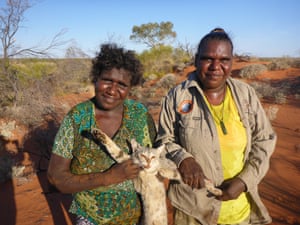By Calla Wahlquist
The Guardian, Australian Edition
Pintupi woman Yukultji
Napangarti displays a dead feral cat which was caught by the Kiwirrkurra
community. Last year the Central Desert Native Title Services introduced a
bounty for cats caught on Kiwirrkurra land to encourage the community to put
more effort into the hunt.
When Pintupi hunters from the Kiwirrkurra community in the Gibson Desert in central Australia catch a feral cat, they have two tasks. The first is to lop off a bit of the tail to give to Central Desert Native Title Services (CDNTS) in exchange for a $100 bounty.
The second is to cut out the stomach, which goes into a dedicated, rather stinky freezer to await the attentions of ecologist Rachel Paltridge, who sifts through the stomach contents in front of a crowd of interested locals on her regular visits to the community.
Paltridge is looking for clues for the cat’s distribution and hunting habits in the entrails, as well as any remnants of threatened species, such as the bilby.
“We don’t often find any bilbies in cat stomachs in central Australia but that partly reflects the low numbers of bilbies in the area – we’d have to be lucky to get the one cat that ate a bilby,” Paltridge told Guardian Australia.
“Other threatened species like the great desert skink we find a bit more. But I am sure that they are eating bilbies – at least the young ones.”
Pintupi and other central desert tribes have been hunting feral cats for their meat for generations, but handing over their stomachs for science is a relatively new step. The CDNTS introduced the bounty for cats caught on Kiwirrkurra traditional lands last year to encourage the community to put more effort into the hunt.
The small, extremely remote community near the Northern Territory border, about 1,200km east of Port Hedland and 850km west of Alice Springs, is one of a few communities where cat hunting is still actively practised.
The hope is that the bounty, which is just enough to cover petrol costs and some compensation for time, will help preserve the rapidly dying skill and provide scientists such as Paltridge with data on the population and eating habits of local feral cats.
In the first 18 months of the scheme, bounty has been claimed for 18 cats. Kate Crossing, a CDNTS land management officer, said that was a pretty good result.Cats are hard to catch, much harder than goanna and kangaroo, the other main bushfoods in the area, and are prized accordingly.
“Pintupi people see cats as a good food source and also as a medicinal food source,” Crossing told Guardian Australia. “A young man has recounted to me about how as a young fellow he was sick and his family went out and got a cat.”
Crossing said while most people from central desert tribes have memories of hunting and eating cat in years past, very few actively practise the skill today, which affects both cultural knowledge and land management.
“The two go hand in hand, being on country to do patch burns and walking around and hunting,” she said. “And that patch-burning is really good for the habitat of native species, particularly bilby.”
The community has applied for a $50,000 grant from the West Australian government to fund a four-month trial of monthly hunting trips to targeted areas within the 4.2m hectare Kiwirrkurra Indigenous Protected Area, including areas of known bilby habitat.
Crossing said the project would allow their “elite strike-force team”, a group of about a dozen highly skilled cat hunters, to work with ecologists to monitor and actively reduce cat predation on threatened species.
The grant would also allow Pintupi trackers to be trained in the use of western hunting techniques such as shooting, baiting, using detector dogs and rubber-lined leg traps. Paltridge said a similar project with the Nyirripi people over the border in the Northern Territory had shown that working with skilled Aboriginal trackers to lay cat traps significantly increased the success rate.
The use of baiting would be limited, however. The WA government released a new type of cat bait, using 1080 poison in a kangaroo-chicken sausage, in June, but it cannot be used in areas where Kiwirrkurra hunters might catch cats for bushmeat, or in areas with a high dingo population, because dingoes also prey on feral cats.
But Paltridge said that over a small area, strategic use of traditional hunting methods could be effective.
“We see this approach to threatened species conservation as an important alternative to relying on predator-proof fencing to protect rare wildlife,” she said.



No comments:
Post a Comment